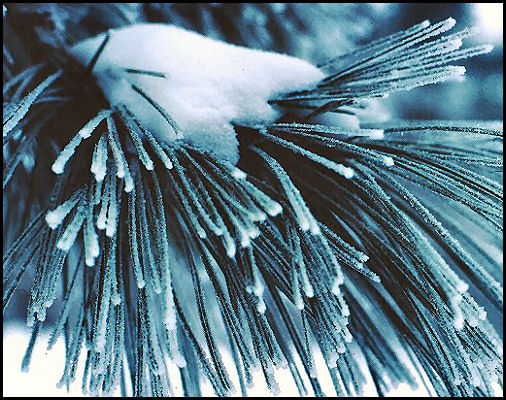|
|
|
|
Winter Adaptations
Article #166, January 2011
By Bill Cook
How do trees survive the winter?
There are two main challenges: the cold and a lack of liquid water. Trees have two main survival strategies: chemical adaptations and structural adaptations.
The height of trees, a good idea in the summer, increases exposure to more extreme winter conditions. Unlike animals, trees cannot move. Unlike many other plants, they don’t have the option to overwinter as seeds or rhizomes.
Bark provides fairly water tight barriers for most tree tissues. The bark also helps protect the tissues from abrasion and physical damage.
However, broad leaves are a major source of water loss, so our northern deciduous tree species drop them in the fall. Needles have proportionately less surface area than leaves. Needles also have better water loss control barriers. Nevertheless, all conifers lose older, more worn-out needles each fall. In the case of tamarack and larch, all needles are dropped.
Conifers have an advantage in needle retention in that they photosynthesize all year, as conditions permit. Deciduous trees must expend a lot of resources to grow new leaves each spring.
Leaf-drop is largely controlled by annual variations in photoperiod. The process begins in late July or early August. The chemistry is intricate but essentially involves pulling goodies out of the leaf and then forming a thin layer of cells where the leaf will eventually break off. Of course, the colorful fall season is the most obvious part of this process.
Ice crystals inside cells are fatal, but ice between cells is not. The “killing temperature” is that point where cells freeze. That temperature varies with species, populations, among individuals, and even between different tissues. Many central hardwood tree species hit their cold threshold in Michigan and Wisconsin, defining their northern range.
Trees acclimate by gradually increasing their cold tolerance. Cells increase lipid concentration with less complex lipids, break apart long protein chains, and water migrates out of the cell. Water outside cell walls will freeze first. As this water changes from liquid to solid, small amounts of heat are released. This energy helps prevent the cellular water freezing. This also causes more cellular water to move outside the cell.
The plumbing between broad-leafed trees and conifers differs considerably. Broad-leafed trees lose most of their ability to move water during the winter. Capillary action is broken after the first freeze. They need to re-grow these tissues in the spring. Alternatively, conifers better accommodate the physics of water. Tubes have special “check valves” that can allow resumption of water movement during the winter, should conditions be just right. The conifer cell walls are stronger than hardwoods, withstanding pressures up to 900 psi, so can better withstand ice expansion.
Liquid water in the winter can be found underground and in the snow. Loss of too much water, without replacement, will kill cells. This can happen in the winter under certain environmental conditions, especially among conifers. If roots cannot replace liquid water lost through needles, then tissues die. Winter kill or winter burn happens when needles lose too much water. It is not usually seen until spring, when the needles turn brown.
Another special winter problem can be frost-cracking. Thin-barked trees, usually hardwoods, exposed to both direct and reflected sunlight can experience bark temperatures into the 70 degree range, even though the air temperature is below freezing. If water moves into the warm underbark tissues, the tree will be vulnerable to rapid freezing and tissue death. As the sun sets, or moves behind something that casts a shadow on the tree, bark surface temperatures can drop too fast for the tissues to react. Ice crystals form inside cells, burst the cell walls, and tissues die. In the spring, the tissues dry-out and then crack, usually on the south or southwest side of the tree. This is common with fruit trees.
Frost-cracking can be easily prevented by shading the trunk. A simple burlap wrap, or other solar barrier, will work.
Winter can also damage trees with heavy snow/ice loads. Certain tree species, such as firs and spruces, are quite flexible, reducing breakage from excessive weight.
High winds will abrade tissue surfaces, which increases water loss. Conifers with dense foliage can better resist wind abrasion. Some conifers exposed to regular strong winter winds, especially white pine, will develop crowns with interesting profiles.
Winter is a challenging time for all living things, including trees. Survival adaptations are both interesting and complex. Maybe something to ponder when you’re house-bound on a cold January day?
- 30 -

Trailer
Bill Cook is an MSU
Extension forester providing educational programming for the Upper Peninsula.
His office is located at the MSU Forest Biomass Innovation Center near
Escanaba. The Center is the headquarters for three MSU Forestry properties in
the U.P., with a combined area of about 8,000 acres. He can be reached at cookwi@msu.edu
or 906-786-1575.
Prepared
by Bill Cook, Forester/Biologist, Michigan State University Extension, 6005
J Road, Escanaba, MI 49829
906-786-1575 (voice), 906-786-9370 (fax), e-mail: cookwi@msu.edu
Use
/ reprinting
of these articles is encouraged. Please notify Bill Cook.
By-line should read "Bill Cook, MSU Extension" Please use the article
trailer whenever possible.
Michigan State University is an affirmative action equal opportunity institution. The U.S. Department of Agriculture prohibits discrimination on the basis of race, color, national origin, gender, religion, age, disability, political beliefs, sexual orientation, and marital status or family status. (Not all prohibited bases apply to all programs.)

This website is maintained by Bill Cook, Michigan State University Extension
Forest in the Upper Peninsula. Comments, questions,
and suggestions are gratefully accepted.
Last
update of this page was
5 November, 2018
This site is hosted by School of Forest Resources and Environmental Science at Michigan Technological University.